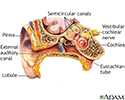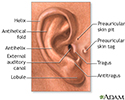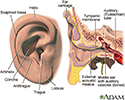Ear - blocked at high altitudes
High altitudes and blocked ears; Flying and blocked ears; Eustachian tube dysfunction - high altitude
The air pressure outside of your body changes as altitude changes. This creates a difference in pressure on the two sides of the eardrum. You may feel pressure and blockage in the ears as a result.
Information
The eustachian tube is a connection between the middle ear (the space behind the eardrum) and the back of the nose and upper throat. This structure connects the middle ear space to the outside world.
Swallowing or yawning opens the eustachian tube and allows air to flow into or out of the middle ear. This helps equalize pressure on either side of the eardrum.
Swallowing or yawning can unclog blocked ears when you are going up or coming down from high altitudes. Chewing gum the entire time you are changing altitudes helps by causing you to swallow often. This may prevent your ears from getting blocked.
People who always have blocked ears when flying may want to take a decongestant about an hour before the flight leaves.
If your ears are blocked, you can try breathing in, then gently breathing out while holding your nostrils and mouth closed. Use care when doing this. If you breathe out too forcefully, you can cause ear infections by forcing bacteria into your ear canals. You can also create a hole (perforation) in your eardrum if you blow too hard.
References
Peak DA. Scuba diving and dysbarism. In: Walls RM, Hockberger RS, Gausche-Hill M, eds. Rosen's Emergency Medicine: Concepts and Clinical Practice. 10th ed. Philadelphia, PA: Elsevier; 2023:chap 131.
Van Hoesen KB, Lang MA. Diving medicine. In: Auerbach PS, Cushing TA, Harris NS, eds. Auerbach's Wilderness Medicine. 7th ed. Philadelphia, PA: Elsevier; 2017:chap 71.
Review Date: 5/2/2024






